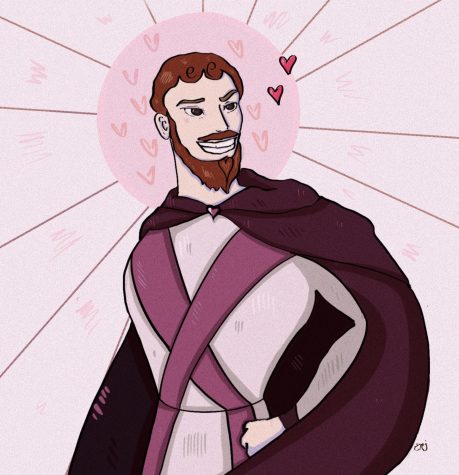Dear Saint Valentine, Who Were You?
As with every year, Valentine’s Day came and went. For some, it may have been an excuse to finally ask a certain person out. For others, it may have just given them a reason to celebrate romance. Love it or hate it, there is no way to escape it. The holiday is so popular in the United States that the country’s flower demands significantly contribute to the economy of Columbia. According to an article by the Washington Post, Columbia’s rose trade during Valentine’s Day accounts for 20% of annual revenue among flower growers. Although the pandemic has impacted celebrations, people have not held back on spending. Based on a survey conducted by the National Retail Federation, the total expected spending in 2022 was at $23.9 billion. That is $3.2 billion more than in 2019!
Obviously, Valentine’s Day is about more than just spending money. At its core, it is a day dedicated to the celebration and appreciation of love – or is it? Picture Valentine’s Day as an image in your head. What does it look like? Are there roses or chocolate? Is there Cupid? Are there hearts? Is it pink? Surprisingly, I found myself with all these great associations but not a clue of where the actual holiday even came from. Now, either I am just completely uninformed, or you, my dear reader, feel the same. Well, a lack of knowledge is easily remedied:

The History of Valentine’s Day
You may know Valentine’s Day as the Day of Saint Valentine. That is because the day got its name from this Catholic saint. Well, in reality, it wasn’t this saint, because no one actually knows who the real St. Valentine is. There are actually at least three different saints named Valentine or Valentinus. Here, the mystery gets interesting: there are also three legends about the actions that made St. Valentine one of the most loved saints of the Middle Ages.
One legend that was passed on recalls Valentine as a Roman priest in the third century who opposed Emperor Claudius II’s “outlaw of marriage for young men.” Valentine became a symbol of love and romance when he continued to perform the celebration in secret, although it eventually became the reason for his death. Another saint, Valentine of Terni, is believed to have been a bishop at the same time and faced the same fate as the priest Valentine. Another legend tells the story of a man helping Christians escape from cruel treatment in Roman prisons. The most elaborate legend, and my personal favorite, recalls a Valentine who was thrown in prison while madly in love with a young girl. When faced with never seeing his love again, he wrote the first valentine’s letter, signing “from your Valentine.” Hence, the expression, “will you be my Valentine?” No matter which story is true (if any are), it is obvious that legend has shaped Valentine as a helpless romantic, a symbol of the virtue of fighting for love.
The Celebration of Saint Valentine
Naturally, it seems that Valentine’s Day may have marked Saint Valentine’s death, a day dedicated to honoring his life. However, although Saint Valentine was a Catholic saint, celebrations of Valentine’s Day can actually be traced back to a pagan festival, the festival of Lupercalia, which falls on February 15th, the day after Valentine’s Day.
Lupercalia has its roots in the Roman legend of Romulus and Remus, as well as the Roman god Faunus, the god of agriculture. The day was dedicated to Faunus and celebrated fertility. Now, if you are thinking that modern-day Valentine’s Day mirrors this ancient festival, you are far from the truth. The actual celebration of Lupercalia was extremely cruel, violent, and sexual. The most bizarre tradition was that “priests would strip the goat’s hide into strips, dip them into the sacrificial blood and take to the streets, gently slapping both women and crop fields with the goat hide”. I for one cannot imagine rejoicing at the prospect of being slapped with animal blood, but you do you ancient Rome, you do you. Some believe that the church’s creation of Valentine’s Day was rooted in a motivation to “Christianize” and draw away attention from the festival, and, after learning the details, maybe this was understandable.
In any way, the church’s Valentine’s Day did actually have one thing in common with the pagan festival. During both, women would enter a raffle to be picked by the eligible young men of the town for a one-year pair up. Love was in the air, even amidst sacrificial, bloody goat hide slapping.
Valentine’s Day in the 21st century
If you feel like you know less about Valentine’s Day now than you did before, do not fret; the history of the day is very mysterious and the best people can do is to create educated hypotheses of what could have been. The essence of Saint Valentine’s Day is one of romance and appreciation, but is that still true today? In an era of declining romance and increasing isolation due to social media, does the day still bring people together? Has love been outcompeted by chocolate and flower advertisements?
These are very good questions (yes, I created them), and I believe I am not suited to answer them alone; so, I let the Harriton student body do so. 44% of the Harriton students who responded replied, “I love it [Valentine’s Day], I always celebrate,” and a few added other responses such as enjoying the theme, aesthetic, and atmosphere of the holiday. However, I was shocked to find out that 24% did not care, 12% believed it to be pure capitalism, and 1 person chose the option “I hate it – it’s stupid.” It is safe to say that I strongly regret agreeing to keep the information anonymous. To whoever said this: I hope your experiences with Valentine’s Day get better, and at least now you can enjoy the history of the holiday.
People overwhelmingly preferred Galentine’s (Friend Valentine’s Day) to Valentine’s, with 72% voting for this fun alternative. From responses, Valentine’s does not seem to make it into the top two holidays of the year, but it is still very loved by many. Multiple responses expressed appreciation for the holiday’s motivation to show appreciation. Even the cynics among us believe, “the idea of taking a day to be extra romantic and lovey-dovey with one’s partner is nice.”
The most important take-away from this survey was that a lot of people were really salty about the day being on a school-filled Monday this year, as most were planning on hanging out with friends, watching rom coms, and giving gifts to significant others. It seems that the rumored pressure or loneliness induced by Valentine’s Day is just that: rumors. But for those of you who may have felt lonely during Valentine’s Day, I hope you feel represented in these wise words:
What do you want to say to your Valentine?
Who even are you but a figment of my sad, lonely life.
— Anonymous Response
Whether Valentine’s Day is your favorite holiday or not, the history of the day is yet to be fully uncovered. No matter what shaped it or how much capitalism may be corrupting its spirit, never forget that it is a day to celebrate those that you love and make you feel loved.
Spread love and Happy very belated V-Day <3
PS. Slightly creepy fact: Did you know that many Catholic institutions display remnants of Saint Valentine? A church in Dublin displays his heart, a basilica in Rome exhibits his skull, in a friary in Glasgow the skeleton of the saint is in a golden box, and more! I know, it’s a little macabre…

Jade-Sophie, an IB senior, is excited to be returning to the Banner as a Science and Tech editor this year. It is her second year writing and she can’t...

Anna is a junior and is excited for her second year making graphics for the Banner. She looks forward to helping illustrate this year. Anna spends her...

This is Trinidad Monteagudo Jackson's second year at The Harriton Banner, and is super excited about creating new graphic designs for articles. She...


